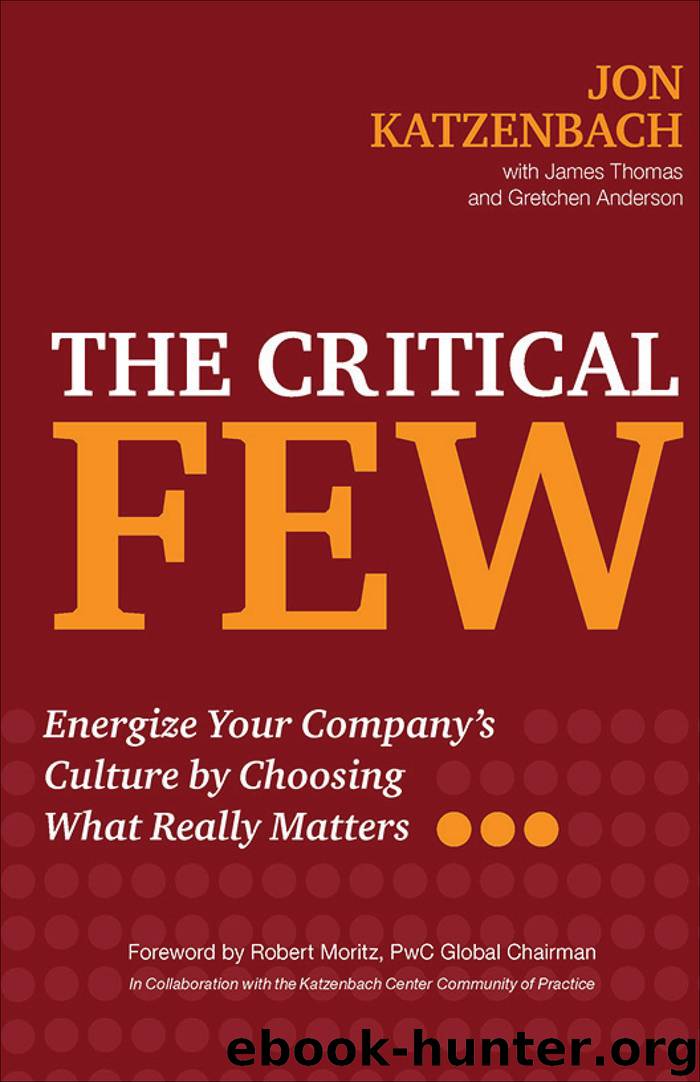The Critical Few by Jon Katzenbach

Author:Jon Katzenbach
Language: eng
Format: epub
Publisher: Berrett-Koehler Publishers
Published: 2018-04-23T16:00:00+00:00
THE POWER OF AUTHENTIC INFORMAL LEADERS
In Katz’s decades of work in this field, one of his formative client experiences was his opportunity to advise General Motors as it climbed out of severe financial distress following its declaration of Chapter 11 in June 2009. For CEO Fritz Henderson, harnessing emotional energy to drive GM’s change priorities was not an option—it was an imperative. Katz’s recollection of early conversations with Henderson are vivid. “Everyone is telling us to change our culture,” Henderson lamented. “And people are going to expect to see it happen right away. In fact, they want it to have happened yesterday. Here’s the trouble: I know that simply isn’t possible. A culture takes shape over decades. This is true anywhere; it is especially true at GM. Our culture is global, complex. It is a challenge just to understand it, let alone to replace it or guide it toward change.”
Henderson; GM’s head of leadership and culture, Chris Oster; and Katz all agreed on a core premise: General Motors’ leaders must work “with and within,” rather than against, the strong prevailing culture. The leadership team decided to identify and execute on four top behavior change priorities: speed of execution, sensible risk, clear accountability, and customer service.
To address the speed of execution, Henderson slashed layers of bureaucracy and dismantled multiple product and strategy boards. In their place, he established a single eight-person executive committee that reported to him directly, twice a week. He also established a senior culture council. This council included manufacturing executive Mary Barra, who later became the head of HR and then, eventually, CEO— the first woman to hold that role in US automotive history. One of the culture council’s tasks was to find out more about how and where these four priorities were already prevalent across the organization. In other words, just as described in the chapters on traits and behaviors, Henderson took a pragmatic approach. He did not try to change the complex GM cultural situation in its entirety toward some ideal defined by an external framework. Instead, he directed his attention to finding answers within the organization.
Henderson believed that steering GM through turbulent waters required a deep, intuitive understanding of culture. His culture council formed a strategy council of very well-respected informal leaders from the front line and middle management to serve as a sounding board and voice of the people: “Fritz’s 50.” Members of this group were not the high potentials on a clear path to senior leadership; rather, they were solid citizens, many of long tenure, most at the front line or lower middle management. To find them, the council consulted traditional sources such as HR records and annual reviews. They also sought stories and anecdotes and relied on their own experience and intuition. They cross-checked their list against the opinions of others who had worked directly with the candidates. When the list was narrowed to the initial fifty, the culture council felt confident that they had found a group who represented, and could articulate, the way that people across General Motors were thinking and feeling.
Download
This site does not store any files on its server. We only index and link to content provided by other sites. Please contact the content providers to delete copyright contents if any and email us, we'll remove relevant links or contents immediately.
| Ethics | Etiquette |
| Fashion & Image | Health & Stress |
| Motivation & Self-Improvement | Work Life Balance |
| Workplace Culture |
Tools of Titans by Timothy Ferriss(8130)
Change Your Questions, Change Your Life by Marilee Adams(7546)
Deep Work by Cal Newport(6793)
Man-made Catastrophes and Risk Information Concealment by Dmitry Chernov & Didier Sornette(5862)
Playing to Win_ How Strategy Really Works by A.G. Lafley & Roger L. Martin(5705)
Digital Minimalism by Cal Newport;(5570)
Big Magic: Creative Living Beyond Fear by Elizabeth Gilbert(5541)
The Slight Edge by Jeff Olson(5309)
Ego Is the Enemy by Ryan Holiday(5211)
The Motivation Myth by Jeff Haden(5113)
Stone's Rules by Roger Stone(4981)
The Laws of Human Nature by Robert Greene(4910)
Tuesdays with Morrie by Mitch Albom(4566)
Eat That Frog! by Brian Tracy(4357)
Rising Strong by Brene Brown(4329)
Skin in the Game by Nassim Nicholas Taleb(4115)
The Money Culture by Michael Lewis(4008)
Bullshit Jobs by David Graeber(3977)
Skin in the Game: Hidden Asymmetries in Daily Life by Nassim Nicholas Taleb(3858)
